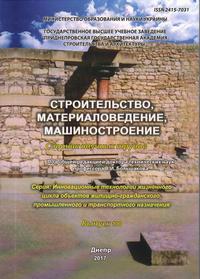Timber as structural material in national and european building codes
Keywords:
timber, mechanical charactericstics, strength classes, volumetric weight, Eurocode 5Abstract
Summary. Structures of solid and glued timber have high popularity in the world. To provide the competitiveness of national building industry on the international market there is ongoing process of implementation of European design standards in Ukraine. The very first step on this direction was an acceptance of current state document on timber structures design [1], on which replacement the new ДСТУ-Н Б В.2.6-184:2012 «Structures of solid and glued timber. Design Guide» was prepared with included rules according to European code called Eurocode 5 [2]. Implementation of European standard in national design practice foresees harmonization of provisions of this standard with national codes. Ft the same time harmonization foresees not only transfer eurostandard rules into national but gradual replacement national codes by European. Objective. To analize the approaches to phisical and mechanical characteristics of structural timber determination according to national Ukrainian and European standards of timber structures design. Results. There is the rsults of analize of the approaches to phisical and mechanical characteristics of structural timber determination according to national Ukrainian and European standards of timber structures design called Eurocode 5, which now is being implementated in Ukraine. The impossibility of momentary transfer in timber structures design to Eurocode 5 without classification of timber growing on Ukraine territory by strength according to its volumetric weight is proved. There are given position-finding data on quality and strength assessment of timber growing on Ukraine territory considering average width and quantity of annual zones. Practical value. Given data will profurther harmonization of normative regulations of Eurocode 5 with national building code.References
DSTU B V.2.6-184:2012 «Structeures of solid and glued timber. Design guide».
EN 1995-1-1:2004 Eurocode 5: Design of timber structures – Part 1-1: General – Common rules and rules for building.
Yurgens N.Е. Wood and its coservation. М.- L.:1930 – 160 pp.
Perelygin L.М. Composition of wood / The USSR Science Academy publishing house. Institute of timber. – М:-1954. –200 pp.
Savkov Е.I. Investigation of physical and mechanical properties of pine timber / «CAGI proceeding». Vol. 62. М., 1930.
Reyharat А.Y., Perelygin L.М. Composition and physical and mechanical properties of wood. М., Goslestehizdat. 1933.
Abramov N.N. Slection of model trees and samples for characterization of main physical and mechanical properties of pine timber. «Proceeding of forestry institute». М., 1934
Jilkin B.D. On influence of influence of vegetation region conditions on anatomic composition, physical and mechanical properties of pine timber. «Proceeding of Bryansk forestry institute» Vol.1 М., 1936.
Saharov М.I. Anatomic composition of pine timber in view of vegetation region conditions. «Proceeding of Bryansk forestry institute», Vol. ІІ and ІІІ. 1940.
SNiP ІІ-25-80. Timber structures. Design code.
Ivanov V.F. Problems of timber structures durability. L.-М.: GSI. 1950. – 135 pp.
Downloads
Published
Issue
Section
License
Редакція Видання категорично засуджує прояви плагіату в статтях та вживає всіх можливих заходів для його недопущення. Плагіат розглядається як форма порушення авторських прав і наукової етики.
При виявлені у статті більш ніж 25% запозиченого тексту без відповідних посилань та використання лапок, стаття кваліфікується як така, що містить плагіат. У цьому випадку стаття більше не розглядається редакцією, а автор отримує перше попередження.
Автори, в статтях яких повторно виявлено плагіат, не зможуть публікуватися в усіх журналах Видавництва ДВНЗ «Придніпровська державна академія будівництва та архітектури».
Автори, які публікуються у цьому журналі, погоджуються з наступними умовами:
- Автори залишають за собою право на авторство своєї роботи та передають журналу право першої публікації цієї роботи на умовах ліцензії Creative Commons Attribution License, котра дозволяє іншим особам вільно розповсюджувати опубліковану роботу з обов'язковим посиланням на авторів оригінальної роботи та першу публікацію роботи у цьому журналі.
- Автори мають право укладати самостійні додаткові угоди щодо неексклюзивного розповсюдження роботи у тому вигляді, в якому вона була опублікована цим журналом (наприклад, розміщувати роботу в електронному сховищі установи або публікувати у складі монографії), за умови збереження посилання на першу публікацію роботи у цьому журналі.
- Політика журналу дозволяє і заохочує розміщення авторами в мережі Інтернет (наприклад, у сховищах установ або на особистих веб-сайтах) рукопису роботи, як до подання цього рукопису до редакції, так і під час його редакційного опрацювання, оскільки це сприяє виникненню продуктивної наукової дискусії та позитивно позначається на оперативності та динаміці цитування опублікованої роботи (див. The Effect of Open Access).

